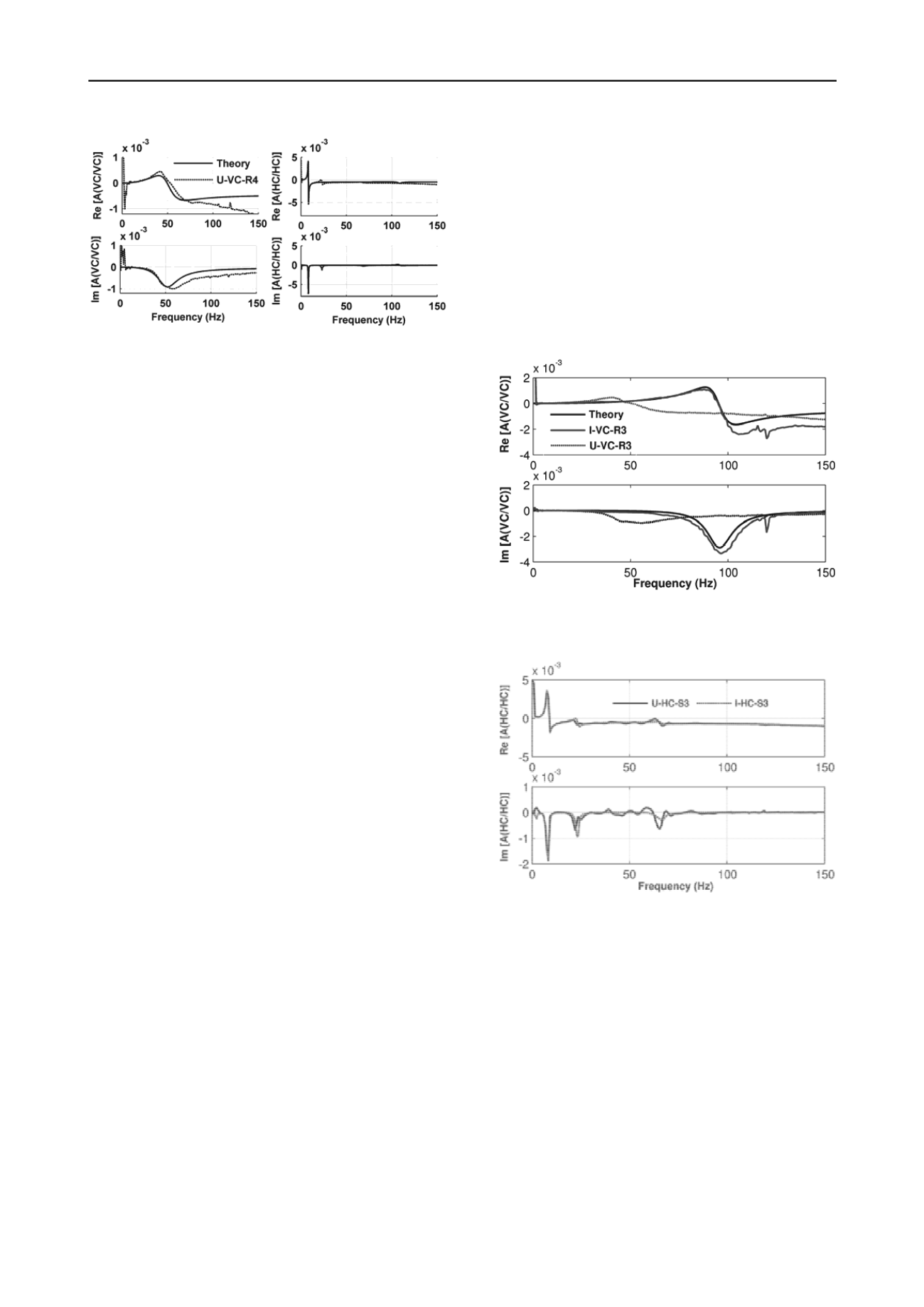
2670
Proceedings of the 18
th
International Conference on Soil Mechanics and Geotechnical Engineering, Paris 2013
Based on unconfined compression tests, the shear strength of
the improved soil is more than 20 times greater than that of the
unimproved soil. One approach for modeling pile I in the
improved soil would therefore be to multiply the modulus
values of Figure 5 by a factor of 20 for the first 4 m depth. On
the other hand, the cement-like properties and mechanical
mixing of the CDSM zone suggest the use of a more uniform
modulus profile compared to the natural soil profile. These
criteria may both be satisfied to some extent by using a modulus
profile proportional to the fourth-root of depth (for curve fitting)
and starting at 75 MPa at the soil surface. Such a profile will
closely follow the natural soil profile below the improved zone.
Although Figure 8 affirms that this modulus profile works very
well for predicting the stiffened vertical mode for pile I in
improved soil, Figure 9 illustrates that the corresponding
experimental horizontal-rocking response was very similar for
the native and improved soil profiles. Although a larger
improved zone would likely be used in practice, the relatively
unchanged dynamic lateral response in this study was
unexpected considering the significant differences in native and
improved soil properties. The similar lateral stiffness may be
related to competing effects of a stiffer improved soil zone, but
a relaxed state of stress in the surrounding soil due to
installation of the CDSM zone, as well as separation between
the CDSM region and surrounding soil from concrete shrinkage
upon curing. The approximate 2D analytical model of Novak
and Aboul-Ella (1978) is unable to incorporate such effects, and
further study of more sophisticated 2-zone models may be
necessary for modeling the observed behavior.
4 CONCLUSION
An experimental program was detailed for a series of full-scale
pile vibration tests employing random vibration techniques. An
approximate numerical elastodynamic model from the literature
was employed to model the experimental results. Parametric
studies revealed that an account of gapping between the pile and
soil may be necessary to accurately model the observed
behavior of the pile in unimproved native soft clay. However,
the theoretical response was shown to be less sensitive to the
modulus profile than to gapping, especially in the horizontal
mode of vibration. The experimental response of the pile in soft
clay was approximately fit by incorporating gapping over the
first 0.3 m and scaling the modulus and damping in the three
major soil layers. The vertical response of the pile in the
improved cement deep soil mixed zone exhibited an increase in
stiffness as expected. However, the horizontal response was
relatively unchanged from that of the native soft clay profile. In
practice, a larger lateral extent of soil improvement would be
used, and a greater improvement in lateral stiffness expected.
The numerical model can be fit to the stiffened vertical mode,
but cannot simultaneously model the relatively unchanged
horizontal stiffness encountered in this study. More
sophisticated computational models will be examined to further
model the latter behavior.
Figure 7. Comparison between experimental accelerance for pile in
unimproved soil and theoretical model using the Hardin & Drnevich
modulus profile with modification factors of (0.8 ,0.8, 0.5) for
modulus and (10,10,10) for damping from top to bottom layers. Left:
vertical response, Right: horizontal response.
5 ACKNOWLEDGEMENTS
This material is based upon work supported by the National
Science Foundation under Grant No. 0936627. This support is
gratefully acknowledged. Any opinions, findings, and
conclusions or recommendations expressed in this material are
those of the authors and do not necessarily reflect the views of
the National Science Foundation. This project was a payload to
the NEESR-SG project 0830328. The assistance of the NEESR-
SG project teams and the nees@UCLA team is appreciated.
Figure 8. Experimental vertical response for pile in improved and
unimproved soils with analytical model prediction for stiffened
CDSM zone.
Figure 9. Representative experimental results for horizontal pile
response in improved and unimproved soils exhibiting minimal
difference.
6 REFERENCES
Ashlock, J.C. and Fotouhi, M.K. (2011). “Characterization of Dynamic
Soil-Pile Interaction by Random Vibration Methods: Experimental
Design and Preliminary Results”, Proceedings of 2011 NSF
Engineering Research and Innovation Conference, Atlanta, Georgia
(CMMI
Grantee
Conference),
11 pp.
Fotouhi, M.K. and Ashlock, J.C. (2012). “Analysis of Experimental
Dynamic Soil-Pile Interaction by Approximate Numerical
Solutions ”, 15th WCEE, Lisbon , Portugal
Mayne, P. W. (2007). Cone Penetration Testing, NCHRP Synthesis 368.
Transportation Research Board, Washington DC.
Novak, M. and Aboul-Ella, F. (1978). Impedance Functions of Piles in
Layered Media. Journal of the Engineering Mechanics Division.
104:6, 643-661.
Hardin, B. O. & Drnevich, V. P. (1972). Shear modulus and damping in
soils: design equation and curves. J. Soil Mech. Found. Engng.
Div., ASCE 98, No. 7, 667–691


